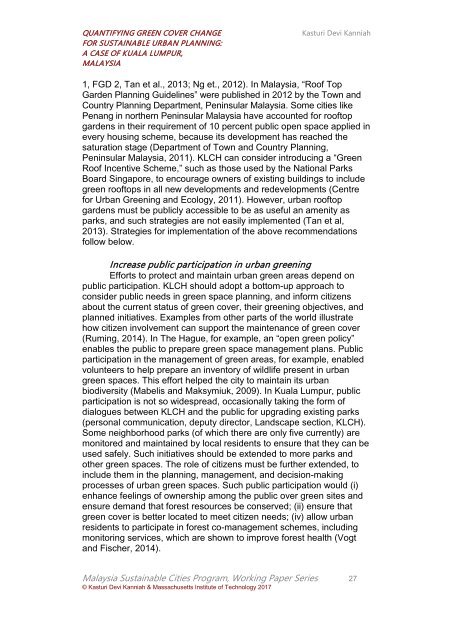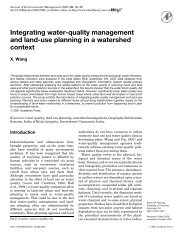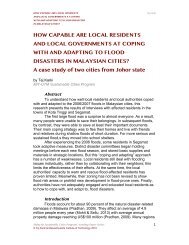Kanniah
Create successful ePaper yourself
Turn your PDF publications into a flip-book with our unique Google optimized e-Paper software.
QUANTIFYING GREEN COVER CHANGE<br />
FOR SUSTAINABLE URBAN PLANNING:<br />
A CASE OF KUALA LUMPUR,<br />
MALAYSIA<br />
Kasturi Devi <strong>Kanniah</strong><br />
1, FGD 2, Tan et al., 2013; Ng et., 2012). In Malaysia, “Roof Top<br />
Garden Planning Guidelines” were published in 2012 by the Town and<br />
Country Planning Department, Peninsular Malaysia. Some cities like<br />
Penang in northern Peninsular Malaysia have accounted for rooftop<br />
gardens in their requirement of 10 percent public open space applied in<br />
every housing scheme, because its development has reached the<br />
saturation stage (Department of Town and Country Planning,<br />
Peninsular Malaysia, 2011). KLCH can consider introducing a “Green<br />
Roof Incentive Scheme,” such as those used by the National Parks<br />
Board Singapore, to encourage owners of existing buildings to include<br />
green rooftops in all new developments and redevelopments (Centre<br />
for Urban Greening and Ecology, 2011). However, urban rooftop<br />
gardens must be publicly accessible to be as useful an amenity as<br />
parks, and such strategies are not easily implemented (Tan et al,<br />
2013). Strategies for implementation of the above recommendations<br />
follow below.<br />
Increase public participation in urban greening<br />
Efforts to protect and maintain urban green areas depend on<br />
public participation. KLCH should adopt a bottom-up approach to<br />
consider public needs in green space planning, and inform citizens<br />
about the current status of green cover, their greening objectives, and<br />
planned initiatives. Examples from other parts of the world illustrate<br />
how citizen involvement can support the maintenance of green cover<br />
(Ruming, 2014). In The Hague, for example, an “open green policy”<br />
enables the public to prepare green space management plans. Public<br />
participation in the management of green areas, for example, enabled<br />
volunteers to help prepare an inventory of wildlife present in urban<br />
green spaces. This effort helped the city to maintain its urban<br />
biodiversity (Mabelis and Maksymiuk, 2009). In Kuala Lumpur, public<br />
participation is not so widespread, occasionally taking the form of<br />
dialogues between KLCH and the public for upgrading existing parks<br />
(personal communication, deputy director, Landscape section, KLCH).<br />
Some neighborhood parks (of which there are only five currently) are<br />
monitored and maintained by local residents to ensure that they can be<br />
used safely. Such initiatives should be extended to more parks and<br />
other green spaces. The role of citizens must be further extended, to<br />
include them in the planning, management, and decision-making<br />
processes of urban green spaces. Such public participation would (i)<br />
enhance feelings of ownership among the public over green sites and<br />
ensure demand that forest resources be conserved; (ii) ensure that<br />
green cover is better located to meet citizen needs; (iv) allow urban<br />
residents to participate in forest co-management schemes, including<br />
monitoring services, which are shown to improve forest health (Vogt<br />
and Fischer, 2014).<br />
Malaysia Sustainable Cities Program, Working Paper Series 27<br />
© Kasturi Devi <strong>Kanniah</strong> & Massachusetts Institute of Technology 2017






